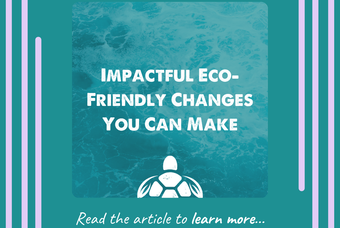The News-Hub/ Articles
Back to Articles
Recommended Articles
Stainless Steel Straws for Drinking - A Fight Against Plastic in 2021.
Plastic straws suck, and not just in a literal sense.
These flimsy and disposable plastic tubes may be a great way to enjoy a drink or two at parties or in restaurants, but they pose one of the greatest threats to our natural world.
An estimated 8.3 billion straws are currently strewn across the planet’s beaches and coastlines. And each of these straws can take up to 300 years to decompose. That’s over 10,000 days that a single plastic straw can wreak havoc on the environment.
When not disposed of correctly, a plastic straw has the potential to:
- Break down into microplastics, which trick seabirds into thinking it’s food for their chicks, leading to thousands of bird fatalities. In fact, over 1 million seabirds die every year due to plastic pollution.
- Suffocate marine life, such as turtles, by blocking their airways. Fifty-two percent of the world’s turtles are thought to have eaten plastic debris at some point during their lifetime.
- Be ingested by fish and contaminate the food chain - every 1 in 3 fish caught contains plastic. This plastic then ends up on our plates and in our own stomachs.
Approximately 1,200 marine species are thought to be harmed by the plastic straws many of us throw away without a seconds’ thought, and it’s estimated that by 2050 there will be more plastic in the ocean than fish.
But it’s not just our oceans and waterways that are affected. Plastic straws and other plastic litter, such as disposable surgical masks, can affect ecosystems on land too. As well as creating visual pollution, during their time on land, chemicals and other toxic substances leach out of plastic straws.
These not only pollute the soil but can lead to dangerous levels of toxins and pollutants in groundwater, posing a risk to everything from the animals in surrounding habitats to those who make use of the earth’s resources: us.
But surely this damage is only caused when plastic straws are discarded irresponsibly, right? Unfortunately not.
Even when plastic straws are disposed of appropriately they can cause issues. Straws are too small to be filtered through the majority of recycling systems, which means that when they make it through our rubbish systems, they are often incinerated, a process which pumps out huge amounts of carbon dioxide and other pollutants into the air.
And if the threat to our soil, waterways and oceans isn’t enough to turn you off using single-use straws for life, plastic straws may also pose a threat to our health.
One of the key components in plastic is Bisphenol A – commonly known as BPA – a chemical compound that many scientific experts believe to alter the hormones in our bodies. Although the effects of BPA in straws are hotly debated, there is evidence to suggest that ingesting BPA can contribute to infertility and even some illnesses such as cancer.
It’s no wonder then that many countries across the world, including England, the Seychelles and Vanuatu, have imposed bans and restrictions on plastic straws and other single-use plastics to help combat plastic pollution. Yet despite these efforts, plastic straws remain an issue, with over 500 million of them being used every single day in the US alone.
So, what’s the solution?
Luckily, there is an alternative to these pesky pieces of plastic: reusable straws.
A Sip Towards a Plastic-Free Future
Choosing to carry your own environment-friendly straw is one small way that you can make a big impact. And, with more and more people vowing to lead a more sustainable lifestyle, there are hundreds of options to choose from.
You can slurp your glass of OJ through glass, enjoy an iced latte with a paper straw and even guzzle your Coke with a straw made out of bamboo. Like with anything, every material has its pros and cons; however, there is one straw on the sustainable scene that stands out from the rest: reusable stainless steel straws.
Strong, lightweight and easily portable, stainless steel straws for drinking not only help to reduce the amount of plastic polluting our environment, but they also provide a sleek, and even stylish, way to sip your favourite drink. Intrigued? Find out everything you need to know before ditching the plastic for this shiny straw alternative and taking a step towards zero waste living below!
Are metal straws and stainless steel straws the same?
Not necessarily. Technically speaking, metal and stainless steel are different types of material: metals, such as copper, naturally occur in the Earth’s crust, whilst stainless steel is an alloy (a product composed of a mixture of metals and other elements). They, therefore, have different properties.
That being said, in terms of straws, most marked up as metal will likely be stainless steel. However, it’s worth checking this before you buy to ensure you’re getting the best quality product; look out for straws that are made up of medical or food-grade stainless steel for maximum straw durability and product safety.
Are metal straws hygienic?
Stainless steel is a non-porous material which means that it doesn’t suck up any nasty bacteria over the course of its lifetime. As long as you clean them thoroughly after each use, metal straws are just as hygienic as disposable plastic ones.
How to clean stainless steel straws?
Some simple washing-up liquid and a good rinse in warm water will do the job. Most reusable straws come with a specially-designed brush so that you can clean your brushes from the inside out. That means you won’t need to worry about any pockets of bacteria lurking inside. Plus, unlike other materials, stainless steel is dishwasher-safe, so you can pop your straws in to wash with minimal effort after each use.
Are stainless steel straws safe?
Yes! Stainless steel is one of the most durable materials on the planet. Not only does it resist oxidation but it also doesn’t corrode, meaning that you can sip your drink through a stainless steel straw with confidence. Metal straws also don’t contain any BPA, unlike its plastic counterparts, so there is no threat of creating a BPA chemical cocktail when you drink.
Why are stainless steel straws better?
As well as being kinder for the planet than plastic ones, stainless steel straws are extremely long-lasting and less prone to breakage, with an estimated lifespan of between 5 to 50 years depending on how well you look after them. So, although you may pay a little more for metal straws than plastic ones initially, you won’t be forking out on more anytime soon.
Ready to reduce your carbon footprint and join the fight against plastic with reusable straws? Then why not check out these high-quality stainless steel straws over in the Purple Turtle Co online shop today! As well as coming two cleaning brushes, these straws come in a nifty drawstring bag so that you can keep your straws with you, wherever you go.
Empty content. Please select category to preview











0 comments. Write a comment